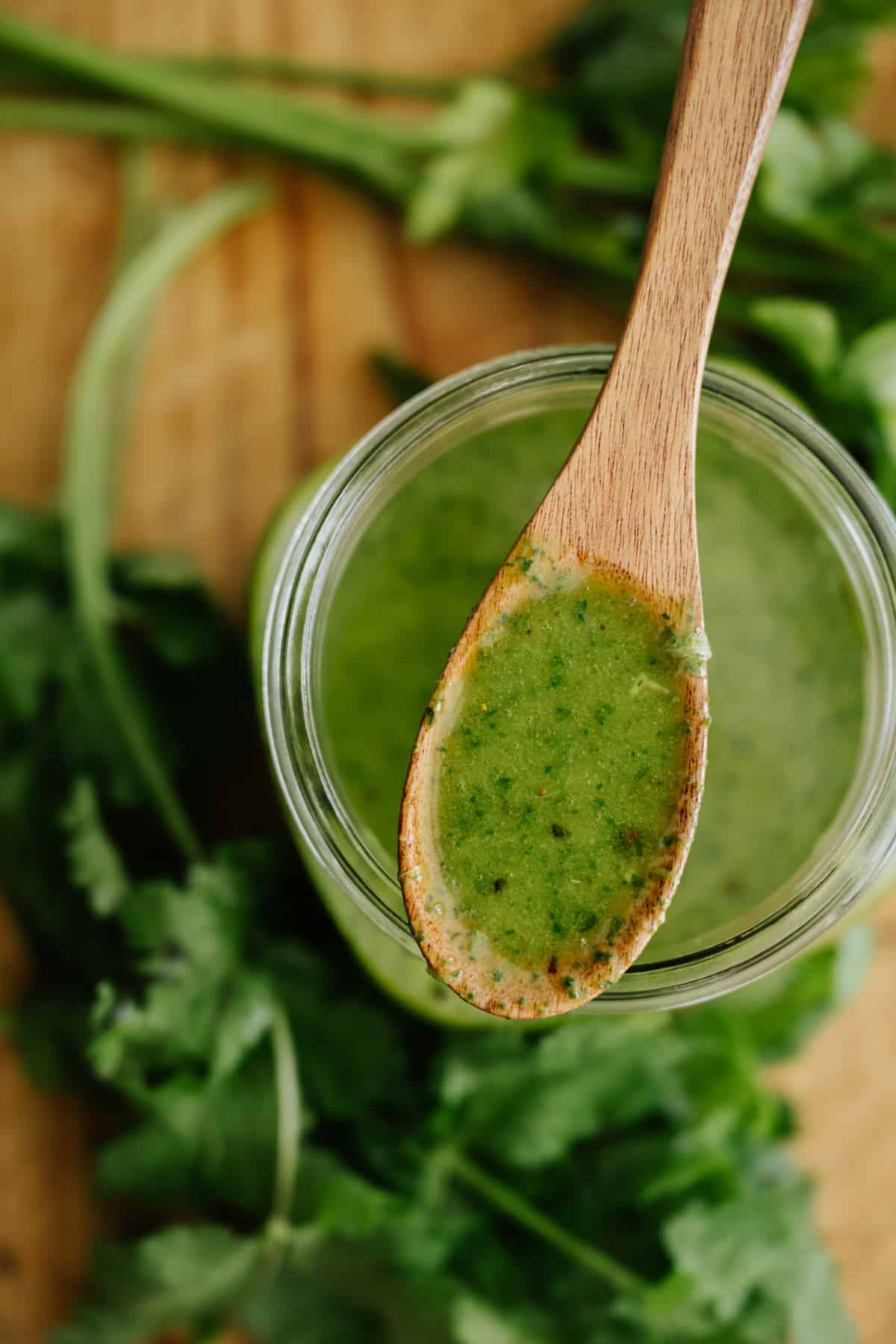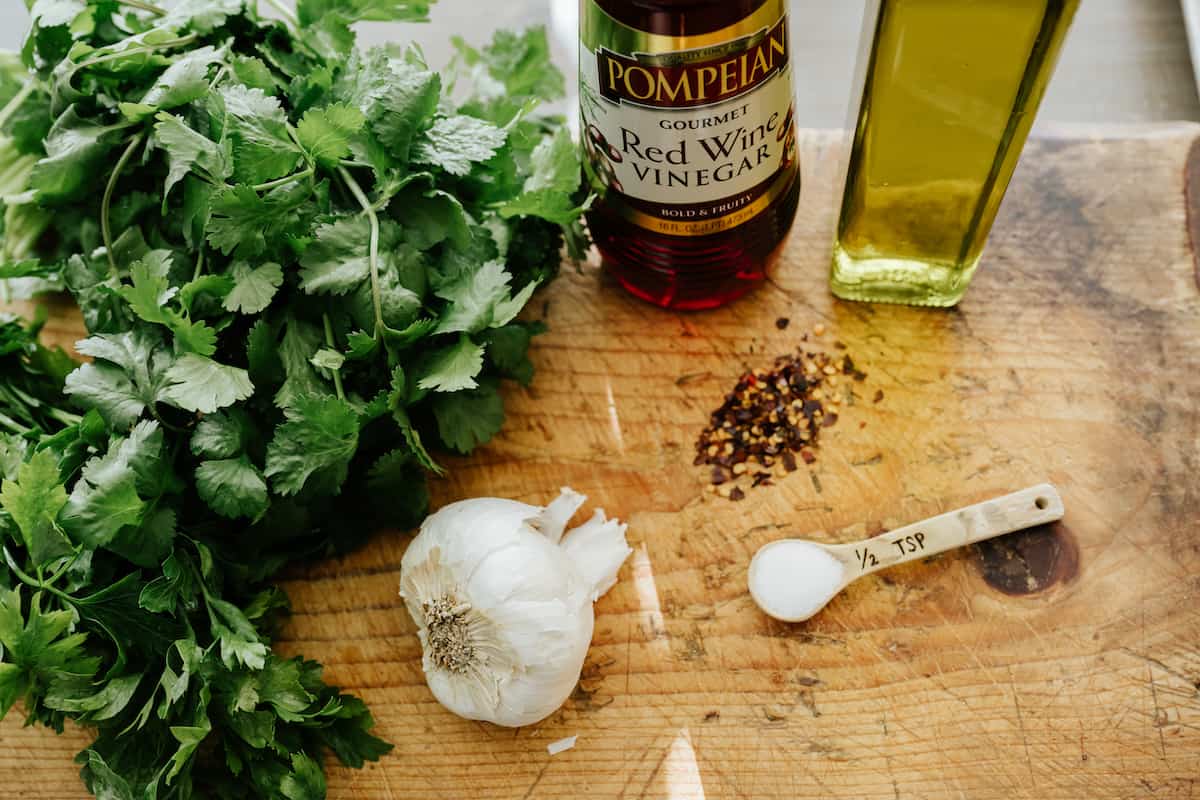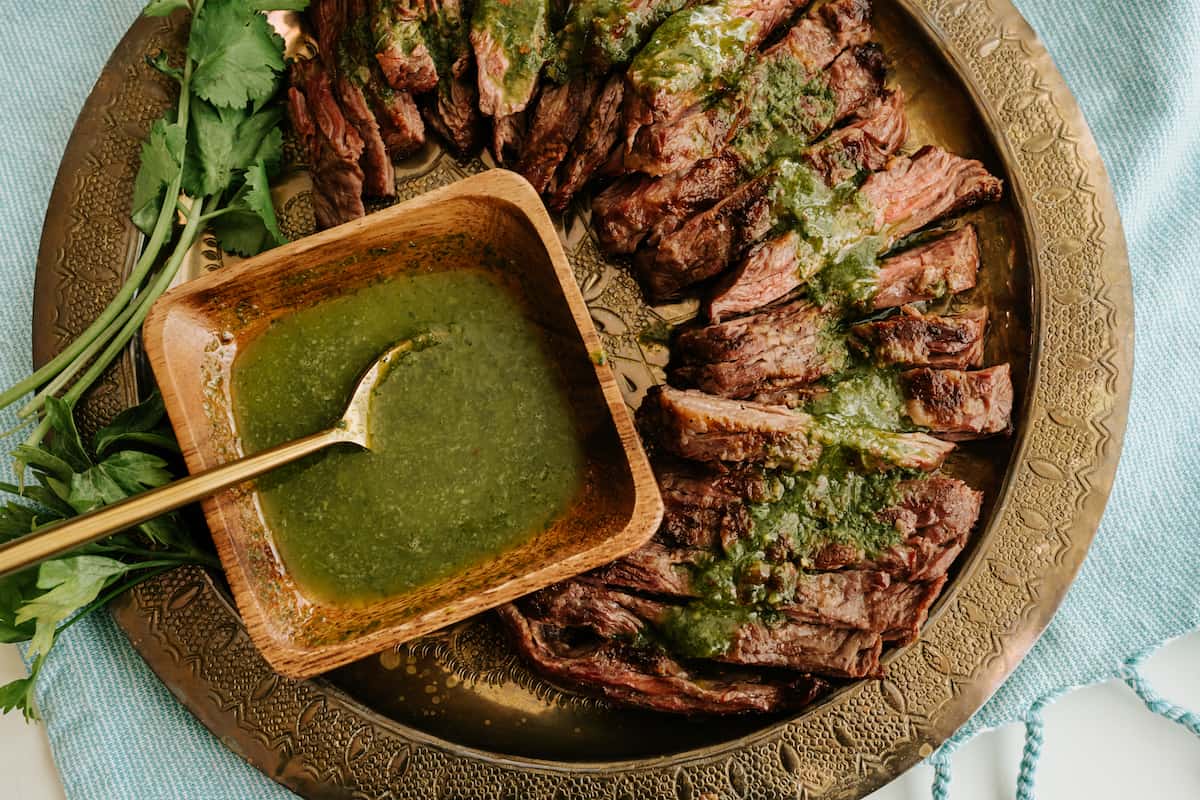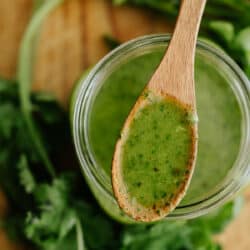Parsley-Cilantro Chimichurri Sauce
Bright, fresh, spicy, and tangy, this easy Parsley-Cilantro Chimichurri Sauce recipe is sure to add lots of pizazz to your favorite meals. Made with fewer than 10 ingredients in less than 10 minutes, this gorgeous Argentinian condiment and marinade is an eternal favorite in our house.

What Is Chimichurri Sauce?
Popular in both Argentina and Uruguay, chimichurri (pronounced “tchi-ME-chur-REE”) is an uncooked sauce or condiment that is usually used to accompany grilled meats (churrasco), particularly beef. I also find it delicious with chicken, pork, fish, and veggies.
Chimichurri is sort of like the Latin American version of a French pistou or Italian pesto, though it is made without nuts or cheese. In fact, it is naturally vegan, soy-free, nut-free, and gluten-free, so it’s a great thing to make no matter what diet you’re on.
While there are lots of variations and recipes for chimichurri, one thing remains constant: it is always made with lots of parsley, garlic, olive oil, and red wine vinegar. Other ingredients — like cilantro or oregano, lemon zest, onions or shallots, and red pepper flakes — vary by region and recipe.
Why I Love This Recipe
Every time I make this cilantro chimichurri sauce I always wonder why I don’t make it more often, especially when I have fresh herbs in my garden. The flavors are so fresh and bright that they can make even the most ho-hum meal taste incredible.
This super tasty and easy-to-make chimichurri sauce recipe features just 8 ingredients including fresh parsley, cilantro, garlic, and tangy vinegar. It gets an extra kick from crushed red pepper because you know I like it hot. Best of all, the prep is almost non-existent. Strip the herbs from their stems, peel the garlic, and then let your blender or food processor do all the work.
My favorite way to enjoy this homemade chimichurri is spooned over grilled beef, but it is also great on any other smoky grilled meats, proteins or veggies. Aside from being a delectable sauce for serving with any kind of mixed grill, it can also be slathered on raw meats for a bright and flavorful chimichurri marinade.
Oh, and if you’re ever looking for a way to add some pep to your WFH lunch, this deliciously herby quasi-pesto is an excellent addition to roast beef or turkey sandwiches. Chimichurri mayo FTW!

Ingredients & Substitutions
As promised, you only need a handful of ingredients to make this dazzling green Argentine chimichurri sauce. Here’s what to gather:
- Italian Parsley – I prefer flat-leafed parsley, but since everything is getting blitzed into oblivion, feel free to use curly parsley instead.
- Fresh Cilantro – I’m someone who could eat cilantro leaves like salad greens, so this is a natural addition. If you’re not a fan, feel free to stick to just parsley or add a few tablespoons of fresh oregano instead.
- Olive Oil – If you have it, this would be an excellent place to use your fancy, cold-pressed, small-batch olive oil. If not, just your normal EVOO will do just fine!
- Red Wine Vinegar – For acidity. Reach for the best quality vinegar you can afford. I happen to like Pompeian Vinegar.
- Garlic – Since this is a fresh sauce, you definitely want to use fresh garlic cloves here.
- Dried Crushed Red Pepper – Feel free to add more or less depending on your heat preference.
- Salt & Pepper – For seasoning.
How To Make Chimichurri Sauce
Making this mostly authentic chimichurri recipe is as simple as can be. Here’s how it’s done:
Step 1: Purée all ingredients in a blender or food processor.
Step 2: Rest. Transfer the sauce to an airtight container and refrigerate for at least 2 hours to allow the flavors to meld. Before serving, stir and season as needed.
Optional Variations
While I think this is the easiest, best chimichurri recipe around, there is always room for customization in the Muy Bueno kitchen. Here are a few variations to consider:
- Parsley Chimichurri – Keep it simple by using parsley as the only herb. Add a few rasps of lemon zest and/or a squeeze of fresh lemon juice to double down on the lemony flavor of the herb.
- Basil Chimichurri – Swap out the cilantro for basil for a fresh take on this classic sauce. Feel free to add some chopped red onion or shallots to the mix for extra interest.
- Mint Chimichurri – Fresh mint is a surprising and delicious addition to this herby sauce. Use it in place of cilantro (or in place of the parsley) for a fresh addition to any plate.
- Red Chimichurri – Adding some smoked paprika and roasted, peeled red peppers will give your cilantro-parsley chimichurri a gorgeous hue and a subtle sweetness.
- Jalapeño Chimichurri – Add extra heat by adding a few roasted and seeded jalapeños to the mix.
Expert Tips
- Make-Ahead – This easy chimichurri recipe is best made several hours or even a day in advance of serving it so the flavors have time to meld. It will last for up to a week in the fridge so you can reap the flavor benefits for many meals to come.
- Save your stems – While you shouldn’t use your parsley or cilantro stems in the recipe, don’t be so quick to toss them in the compost. Save them in a gallon-sized zip-top bag in the freezer alongside your carrot tops, onion and garlic skins, and other veggie scraps. When the bag is full, add it to a stockpot and cover with water then simmer for 4-12 hours on low to make homemade vegetable stock. Doesn’t free taste great?!?
- Store in a squeeze bottle – While you’re welcome to store your chimichurri in any airtight container, I love keeping it in a squeeze bottle in the door of my fridge. That way, whenever I need a burst of bright, herbaceous flavor, all I have to do is grab and squeeze — no spoons or knives required.
Frequently Asked Questions
Fresh, herby, garlicky, and green with a perfect balance of spicy and acidic flavors. In other words, it tastes like a party in your mouth!
Argentines and Uruguayans usually use chimichurri as an accompaniment for grilled meat. While steak is probably the most popular pairing with the sauce, I also love it with any other meat from the grill like pork, chicken, lamb, and fish.
You can also use it to dress up your favorite veggies, swipe in on your sandwiches and wraps, or stir it into cooked rice or grains for a zesty and easy side.

Recipes For Using Argentinian Chimichurri Sauce:
- Grilled Skirt Steak with Chimichurri Sauce
- Tri-Tip Sandwich with Chimichurri Sauce (Tortas de Bistec)
- Carne Asada Tortas with Chimichurri Sauce
- Steak Fajitas with Grilled Onions, Peppers, and Roasted Cherry Tomatoes with Chimichurri Sauce
- Smoked Ham and Chimichurri Panini

Parsley-Cilantro Chimichurri Sauce
Ingredients
Instructions
- Puree all ingredients in a blender or food processor.
- Transfer sauce to an airtight container and refrigerate at least 2 hours or up to 1 day to allow the flavors to meld. Before serving, stir and season as needed.
Notes
- Parsley Chimichurri – Keep it simple by using parsley as the only herb. Add a few rasps of lemon zest and/or a squeeze of fresh lemon juice to double down on the lemony flavor of the herb.
- Basil Chimichurri – Swap out the cilantro for basil for a fresh take on this classic sauce. Feel free to add some chopped red onion or shallots to the mix for extra interest.
- Mint Chimichurri – Fresh mint is a surprising and delicious addition to this herby sauce. Use it in place of cilantro (or in place of the parsley) for a fresh addition to any plate.
- Red Chimichurri – Adding some smoked paprika and roasted, peeled red peppers will give your cilantro-parsley chimichurri a gorgeous hue and a subtle sweetness.
- Jalapeño Chimichurri – Add extra heat by adding a few roasted and seeded jalapeños to the mix.
- Make-Ahead – This easy chimichurri recipe is best made several hours or even a day in advance of serving it so the flavors have time to meld. It will last for up to a week in the fridge so you can reap the flavor benefits for many meals to come.
- Save your stems – While you shouldn’t use your parsley or cilantro stems in the recipe, don’t be so quick to toss them in the compost. Save them in a gallon-sized zip-top bag in the freezer alongside your carrot tops, onion and garlic skins, and other veggie scraps. When the bag is full, add it to a stockpot and cover with water then simmer for 4-12 hours on low to make homemade vegetable stock. Doesn’t free taste great?!?
- Store in a squeeze bottle – While you’re welcome to store your chimichurri in any airtight container, I love keeping it in a squeeze bottle in the door of my fridge. That way, whenever I need a burst of bright, herbaceous flavor, all I have to do is grab and squeeze — no spoons or knives required.
Photography by Jenna Sparks
Originally published: June 2017
 Muy Bueno: Fiestas
Muy Bueno: Fiestas 


5 Comments on “Parsley-Cilantro Chimichurri Sauce”
Easy to make and AMAZING flavor, it’s GREAT on everything. One of favorites!
This is my go to recipe, I make double batch when I make it and it just seems to disappear. It’s great on our my meats and use it on my salads as a dressing too.
I have to say this is my first time that I ever try chimichurri and your recipe was great with a touch of heat, thank you for that recipe.
Delicious!! Perfect on carne asada. I’d add a pic but there isn’t a field on this form.
It’s interesting when you said that fresh ingredients are important for a great recipe. My cousin mentioned to me last night that he is searching for a wholesaler of Chimichurri to use in the recipe for our family reunions, and he asked if I had any suggestions for where he should look. Thanks to this helpful post, I’ll be sure to advise him that he should contact a reputable Chimichurri wholesaler for further information. https://cordobafoods.com